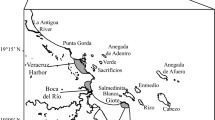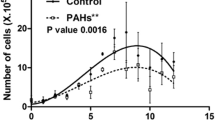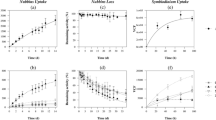Abstract
The fate of the polycyclic aromatic hydrocarbon [3H]benzo[a]pyrene (BaP) was examined in two species of scleractinian corals, Favia fragum (Esper) and Montastrea annularis (Ellis and Solander), which were collected in the patch reefs surrounding Alina's Reef (25°23.25′N; 80°09.8′W) in Biscayne National Park, Florida, USA, in July, 1990. Corals were exposed to initial concentrations of 5 μg/l in a simple static system for 25 h. BaP uptake was estimated from the disappearance of BaP from the water. Uptake rates were 6.5±0.7 and 10.8±0.2 μg BaP cm-2h-1 for F. fragum and M. annularis, respectively, at initial BaP concentrations and were directly proportional to the concentration of BaP in the water. The separation of zooxanthellae from coral tissue revealed that zooxanthellae can accumulate up to 53 and 64% of the total BaP-derived radioactivity present in F. fragum and M. annularis, respectively. Both corals metabolized BaP slowly, as most of the accumulated radioactivity was present as the unmetabolized chemical. However, aqueous and organic-soluble metabolites were found in both the animal and zooxanthellae fractions. Analysis by high-performance liquid chromatography (HPLC) revealed that both species of corals metabolized BaP to various tetrols, triols, dihydrodiols, quinones and phenols, although the pattern of metabolites differed between species. Zooxanthellae contained some of the same Phase I metabolites found in the animal tissue; however, tetrols and triols were absent in extracts from the zooxanthellae. The elimination of BAP from corals was also slow; approximately 38 and 65% of the accumulated radioactivity was still present in F. fragum and M. annularis, respectively, 144 h following the transfer of exposed corals to an uncontaminated flow-through seawater system.
Similar content being viewed by others
Literature cited
Ambrose, H. W., Ambrose, K. P. (1981). A handbook of biological investigation. Hunter Publishing Co., Winston-Salem, North Carolina
Benson, A. A., Patton, J. S., Abraham, S. (1978). Energy exchange in coral reef ecosystems. Atoll Res. Bull. 220: 33–52
Black, S. D., Coon, M. J. (1987). P450 cytochromes: structure and function. Adv. Enzymol. relat. Areas molec. Biol. 60: 35–87
Buhler, D. R., Williams, D. E. (1989). Enzymes involved in metabolism of PAH by fishes and other aquatic animals: oxidative enzymes (or phase 1 enzymes). In: Varanasi, U. (ed.) Metabolism of polycyclic aromatic hydrocarbons in the aquatic environment. CRC Press, Inc., Boca Raton, Florida, p. 151–184
Burns, K. A., Knap, A. H. (1989). The Bahia las Minas oil spill hydrocarbon uptake by reef building corals. Mar. Pollut. Bull. 20: 391–398
Cook, C. B., Knap, A. H. (1983). Effects of crude oil and chemical dispersant on photosynthesis in the brain coral Diploria strigosa. Mar. Biol. 78: 21–27
Den Besten, P. J., Livingstone, D. L. (1989). Mixed-function oxygenase system and benzo[a]pyrene metabolism in echinoderms. Mar. envirl Res. 28: 19–23
Edmonds, P. J., Roberts, D. A., Singer, R. (1990). Reefs of the northeastern Caribbean. I. Scleractinian populations. Bull. mar. Sci. 46: 780–789
Egaas, E., Varanasi, U. (1982). Effects of polychlorinated biphenyls and environmental temperature on in vivo formation of benzo[a]pyrene metabolites by liver of trout (Salmo gairdneri). Biochem. Pharmac. 31: 561–566
Elnenaey, E. A., Schoor, W. P. (1981). The separation of the isomeric phenols of benzo[a]pyrene by high-performance liquid chromatography. Analyt. Biochem. 111: 393–400
Gassman, N. J., Kennedy, C. J. (1992). Characterization of cytochrome P-450 and xenobiotic metabolizing enzyme activities in the scleractinian coral, Favia fragum (Esper). Bull. mar. Sci. (in press)
Gelboin, H. V., Ts's, P. O. P. (1978–1981). Polycyclic hydrocarbons and cancer. Vols. 2–3. Academic Press, New York
Glynn, P. W. (1984). Widespread coral mortality and the 1982–83 El Niño warming event. Envir. Conserv. 10: 149–154
Glynn, P. W., Howard, L. S., Corcoran, E., Freay, A. D. (1984). The occurrence and toxicity of herbicides in reef building corals. Mar. Pollut. Bull 15: 370–374
Glynn, P. W., Szmant, A. M., Corcoran, E. F., Cofer-Shabica, S. V. (1989). Condition of coral reef cnidarians from the northern Florida reef tract: pesticides, heavy metals, and histopathological examination. Mar. Pollut. Bull. 20: 568–576
Guzman, H. M., Jackson, J. B. C., Weil, E. (1991). Short-term ecological consequences of a major oil spill on Panamanian subtidal reef corals. Coral Reefs 10: 1–12
Harland, A. D., Brown, B. E. (1989). Metal tolerance in the scleractinian coral Porites lutea. Mar. Pollut. Bull. 20: 353–357
Harland, A. D., Nganro, N. R. (1990). Copper uptake by the sea anemone Anemonia viridis and the role of zooxanthellae in metal regulation. Mar. Biol. 104: 297–301
Jackson, J. B. C., Cubit, J. D., Keller, B. D., Baptista, V., Burns, K., Caffey, H. M., Caldwell, R. L., Garrity, S. D., Getter, C. D., Gonzalez, C., Guzman, H. M., Kauffman, K. W., Knap, A. H., Levings, S. C., Marshall, M. J., Steger, R., Thompson, R. C., Weil, E. (1989). Ecological effects of a major oil spill on Panamanian coastal marine communities. Science, N.Y. 243: 37–44
Kapitulnik, J., Wislocki, P. G., Levin, W. (1978). Tumorigenicity studies with diolepoxides of benzo[a]pyrene which indicate that [±]trans-7.8-dihydroxy-91,10a-epoxide is an ultimate carcinogen in newborn mice. Cancer Res. 38: 354–358
Kennedy, C. J., Gill, K. A., Walsh, P. J. (1989). Thermal modulation of benzo[a]pyrene metabolism by the gulf toadfish, Opsanus beta. Aquat. Toxic. 15: 331–344
Knap, A. H., Solbakken, J. E., Dodge, R. E., Sleeter, T. D., Wyers, S. J., Palmork, K. H. (1982). Accumulation and elimination of (9-14C) phenanthrene in the reef-building coral (Diploria strigosa). Bull. envir. Contam. Toxic. 28: 281–284
Kokke, W. C. M. C., Fenical, W., Bohlin, L., Djerassi, C. (1981) Sterol synthesis by cultured zooxanthellae; implications concerning sterol metabolism in the host-symbiont association in Caribbean gorgonians. Comp. Biochem. Physiol. 68B: 281–287
Lee, R. F. (1981). Mixed function oxygenases (MFO) in marine invertebrates. Mar. Biol. Lett. 2: 87–105
Loya, Y., Rinkeyich, B. (1980). Effects of oil pollution on coral reef communities. Mar. Ecol. Prog. Ser. 3: 167–180
Marsh, J. A. (1970). Primary productivity of reef-building calcareous red algae. Ecology 51: 255–263
McElroy, A. E., Farrington, J. W., Teal, J. M. (1989). Bioavailability of polycyclic hydrocarbons in the aquatic environment. In: Varanasi, U. (ed.) Metabolism of polycyclic aromatic hydrocarbons in the aquatic environment. CRC Press, Inc., Boca Raton, Florida, p. 1–39
Patton, J. S., Abraham, S., Benson, A. A. (1977). Lipogenesis in the intact coral Pocillopora capitata and its isolated zooxanthellae: evidence for a light-driven carbon cycle between symbiont and host. Mar. Biol. 44: 235–247
Patton, J. S., Burris, J. E. (1983). Lipid synthesis and extrusion by freshly isolated zooxanthellae (symbiotic algae). Mar. Biol. 75: 131–136
Peters, E. C., Meyers, P. A., Yevich, P. P., Blake, N. J. (1981). Bioaccumulation and histopathological effects of oil on a stony coral. Mar. Pollut. 12: 333–339
Rinkevich, B., Loya, Y. (1977). Harmful effects of chronic oil pollution on a Red Sea scleractinian coral population. Proc. 3rd. int. coral Reef Symp., Miami, Florida 2: 585–591
Rinkevich, B., Loya, Y. (1979). Laboratory experiments on the effects of crude oil on the Red Sea coral Stylophora pistillata. Mar. Pollut. Bull. 10: 328–330
Schneider, R. (1982). Polychlorinated biphenyls (PCBs) in cod tissues from the Western Baltic: significance of equilibrium partitioning and lipid composition in the bioaccumulation of lipophilic pollutants in gill-breathing animals. Meeresforsch. Rep. mar. Res. 29: 69–79 (Ber. dt. wiss. Kommn Meeresforsch.)
Shugart, L., McCarthy, J., Jimenez, B., Daniels, J. (1987). Analysis of adduct formation in the bluegill sunfish (Lepomis macrochirus) between benzo[a]pyrene and DNA of the liver and hemoglobin of the erythrocyte. Aquat. Toxic. 9: 319–325
Solbakken, J. E., Jeffrey, F. M. H., Knap, A. H., Palmork, K. H. (1982). Accumulation and elimination of 9-14C phenanthrene in the calico clam (Macrocallista maculata). Bull. envir. Contam. Toxic. 28: 530–534
Solbakken, J. E., Knap, A. H., Orr, P. L. (1985) Uptake and elimination of lindane and a phthlate ester in tropical corals and mussels. Mar. envirl Res. 16: 103–113
Solbakken, J. E., Knap, A. H., Sleeter, T. D., Searle, C. E., Palmork, K. H. (1984). Investigation into the fate of 14C-labelled xenobiotics (naphthalene, phenanthrene, 2,4,5,2′,4′,5′-hexachlorobiphenyl, octachlorostyrene) in Bermudian corals. Mar. Ecol. Prog. Ser. 16: 149–154
Szmant, A. M. (1986) Reproductive ecology of Caribbean reef corals. Coral Reefs 5: 43–53
Szmant, A. M., Ferrer, L. M., FitzGerald, L. M. (1990). Nitrogen excretion and O:N ratios in reefs corals: evidence for conservation of nitrogen. Mar. Biol. 104: 119–127
Szmant, A. M., Gassman, N. J. (1990). The effects of prolonged “bleaching” on the tissue biomass and reproduction of the reef coral Montastrea annularis. Coral Reefs 8: 217–224
Zar, J. H. (1974). Biostatistical analysis. Prentice-Hall, Englewood Cliffs, New Jersey
Author information
Authors and Affiliations
Additional information
Communicated by M. G. Hadfield, Honolulu
Rights and permissions
About this article
Cite this article
Kennedy, C.J., Gassman, N.J. & Walsh, P.J. The fate of benzo[a]pyrene in the scleractinian corals Favia fragum and Montastrea annularis . Marine Biology 113, 313–318 (1992). https://doi.org/10.1007/BF00347286
Accepted:
Issue Date:
DOI: https://doi.org/10.1007/BF00347286




